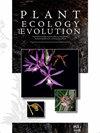A new Ypsilopus (Orchidaceae, Angraecinae) from Zimbabwe and notes on the parallel evolution of extreme column exsertion in African angraecoids
IF 1.3
4区 生物学
Q3 PLANT SCIENCES
引用次数: 0
Abstract
Background and aims – A preliminary review of hawkmoth-pollinated angraecoids from Africa unveiled a remarkable case of parallel evolution of extreme column exsertion between the two species formerly classified in in the defunct genus Barombia . These belong to one clade of Aerangis , including A. gracillima and A. stelligera , and Ypsilopus sect. Barombiella, including Y. amaniensis and Y. schliebenii . The exploration of the geographical distribution of these two clades, followed by an examination of morphological variation within Y. sect. Barombiella, revealed that the disjunct population identified as Y. amaniensis from Zimbabwe represents an undescribed species. Material and methods – Occurrence records of Ypsilopus amaniensis , Y. schliebenii , Aerangis gracillima , and A. stelligera were comprehensively mapped and distribution patterns were visually analysed. Pollination syndromes and pollinaria attachment sites were inferred based on a review of floral and hawkmoth morphology. Standard herbarium practices and mining of photographs of wild and cultivated plants in social media allowed the description of the novelty. Key results – Ypsilopus zimbabweensis sp. nov. (Y. sect. Barombiella) is a narrow endemic of significant horticultural interest and it is preliminarily assessed as Endangered. The evolution of a Barombia -type column presents a parallel geographical pattern in the Aerangis gracillima – A. stelligera clade and Ypsilopus sect. Barombiella and probably induced a shift of pollen placement sites in these sphingophilous species.津巴布韦一新种(兰科,桔梗科)及非洲桔梗类极柱外露平行进化的注解
背景和目的——对来自非洲的以飞蛾为传粉媒介的anggraecoids进行了初步研究,揭示了两个物种之间极端柱状外露的平行进化的显著案例,这两个物种以前被归类为已灭绝的Barombia属。这两个分支分别属于一个分支(包括A. gracillima和A. stelligera)和一个分支(包括Y. amaniensis和Y. schliebenii)。对这两个分支的地理分布进行了探索,随后对Y. Barombiella节的形态变异进行了检查,结果表明,来自津巴布韦的被鉴定为Y. amaniensis的分离种群代表了一个未被描述的物种。材料与方法——对阿曼伊普罗普斯、施勒贝伊氏伊蚊、格氏伊蚊、星氏伊蚊的发生记录进行了综合制图,并对其分布格局进行了目测分析。通过对花和飞蛾形态的回顾,推断传粉综合征和传粉体附着位点。标准的植物标本馆实践和对社交媒体上野生和栽培植物照片的挖掘,使这种新奇的描述成为可能。主要结果-津巴布韦绿盲蝽(Ypsilopus zimbabwe sp. 11 .)是一种具有重要园艺价值的狭窄地方性植物,初步被评估为濒危物种。Barombia型柱的进化在大叶猴- a . stelligera分支和巴罗普斯(Ypsilopus)门Barombiella分支中呈现平行的地理格局,可能导致了这些鞘类物种花粉放置位置的转移。
本文章由计算机程序翻译,如有差异,请以英文原文为准。
求助全文
约1分钟内获得全文
求助全文
来源期刊

Plant Ecology and Evolution
PLANT SCIENCES-
CiteScore
2.20
自引率
9.10%
发文量
27
审稿时长
>12 weeks
期刊介绍:
Plant Ecology and Evolution is an international peer-reviewed journal devoted to ecology, phylogenetics and systematics of all ‘plant’ groups in the traditional sense (including algae, cyanobacteria, fungi, myxomycetes), also covering related fields.
The journal is published by Meise Botanic Garden and the Royal Botanical Society of Belgium.
 求助内容:
求助内容: 应助结果提醒方式:
应助结果提醒方式:


